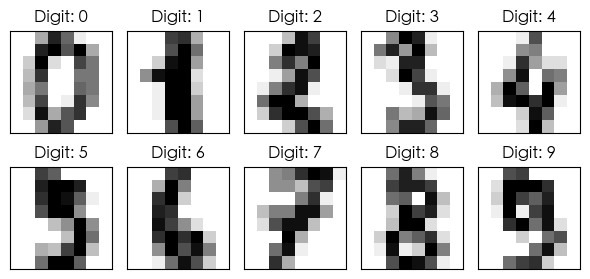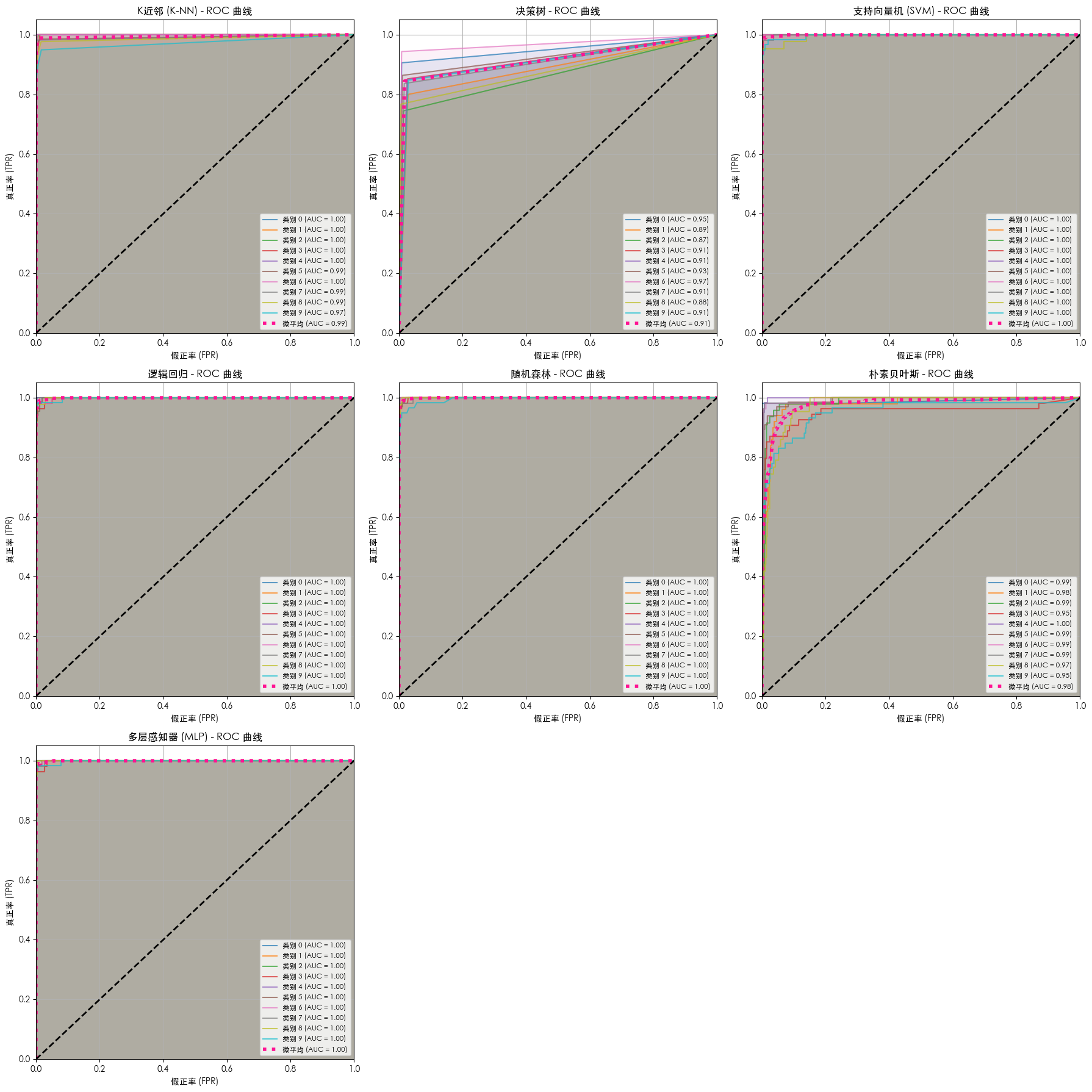背景
digits 手写数字数据集,1797个样本,8x8像素灰度图像(64个特征),10个类别(0-9)
作为多分类任务的玩具数据,需要使用分类方法进行分析

步骤
- 加载数据集
- 拆分训练集、测试集
- 数据预处理(标准化)
- 选择模型
- 模型训练(拟合)
- 测试模型效果
- 评估模型
分析方法
对数据集使用 7 种分类方法进行分析
- K 近邻(K-NN)
- 决策树
- 支持向量机(SVM)
- 逻辑回归
- 随机森林
- 朴素贝叶斯
- 多层感知机(MLP)
代码
python
from sklearn.datasets import load_digits
from sklearn.model_selection import train_test_split
from sklearn.preprocessing import StandardScaler
from sklearn.decomposition import PCA
from sklearn.neighbors import KNeighborsClassifier
from sklearn.tree import DecisionTreeClassifier
from sklearn.svm import SVC
from sklearn.linear_model import LogisticRegression
from sklearn.ensemble import RandomForestClassifier
from sklearn.naive_bayes import GaussianNB
from sklearn.neural_network import MLPClassifier
from sklearn.metrics import accuracy_score, classification_report, roc_curve, auc
from sklearn.preprocessing import label_binarize
import matplotlib.pyplot as plt
import numpy as np
# 设置 Matplotlib 字体以正确显示中文
# 尝试使用多种常见中文字体,提高跨平台兼容性
plt.rcParams['font.sans-serif'] = ['SimHei', 'WenQuanYi Zen Hei', 'STHeiti', 'Arial Unicode MS']
# 解决保存图像时负号'-'显示为方块的问题
plt.rcParams['axes.unicode_minus'] = False
def perform_digits_analysis():
"""
使用 scikit-learn 对手写数字数据集进行全面的分析。
该函数包含数据加载、预处理、模型训练、评估和 ROC/AUC 可视化。
"""
print("--- 正在加载手写数字数据集 ---")
# 加载手写数字数据集
digits = load_digits()
# 获取数据特征和目标标签
X = digits.data
y = digits.target
target_names = [str(i) for i in digits.target_names]
print("\n--- 数据集概览 ---")
print(f"数据形状: {X.shape}")
print(f"目标名称: {target_names}")
# 将数据集划分为训练集和测试集
X_train, X_test, y_train, y_test = train_test_split(X, y, test_size=0.3, random_state=42)
print("\n--- 数据划分结果 ---")
print(f"训练集形状: {X_train.shape}")
print(f"测试集形状: {X_test.shape}")
# 数据标准化
print("\n--- 正在对数据进行标准化处理 ---")
scaler = StandardScaler()
X_train_scaled = scaler.fit_transform(X_train)
X_test_scaled = scaler.transform(X_test)
# 定义并训练多个分类器模型
models = {
"K近邻 (K-NN)": KNeighborsClassifier(n_neighbors=3),
"决策树": DecisionTreeClassifier(random_state=42),
"支持向量机 (SVM)": SVC(kernel='rbf', C=1.0, random_state=42, probability=True), # 必须设置 probability=True 来获取概率
"逻辑回归": LogisticRegression(random_state=42, max_iter=1000),
"随机森林": RandomForestClassifier(random_state=42),
"朴素贝叶斯": GaussianNB(),
"多层感知器 (MLP)": MLPClassifier(random_state=42, max_iter=300)
}
print("\n--- 模型训练与评估 ---")
for name, model in models.items():
print(f"\n--- 正在训练 {name} 模型 ---")
# 使用标准化后的训练数据对模型进行拟合 (训练)
model.fit(X_train_scaled, y_train)
# 在标准化后的测试集上进行预测
y_pred = model.predict(X_test_scaled)
# 评估模型性能
accuracy = accuracy_score(y_test, y_pred)
report = classification_report(y_test, y_pred, target_names=target_names)
print(f"{name} 模型的准确率: {accuracy:.4f}")
print(f"{name} 模型的分类报告:\n{report}")
print("\n--- ROC 曲线和 AUC 对比 ---")
# 创建一个包含多个子图的图表
num_models = len(models)
cols = 3
rows = (num_models + cols - 1) // cols
fig, axes = plt.subplots(rows, cols, figsize=(18, 6 * rows))
axes = axes.flatten()
# 将多分类标签二值化,用于 ROC 曲线计算
y_test_bin = label_binarize(y_test, classes=np.arange(10))
# 循环遍历每个模型并绘制 ROC 曲线
for i, (name, model) in enumerate(models.items()):
ax = axes[i]
# 获取每个类别的预测概率
if hasattr(model, "predict_proba"):
y_score = model.predict_proba(X_test_scaled)
else: # 对于 SVC 这种没有 predict_proba 的模型,使用 decision_function
y_score = model.decision_function(X_test_scaled)
# 计算每个类别的 ROC 曲线和 AUC
fpr = dict()
tpr = dict()
roc_auc = dict()
for j in range(len(target_names)):
fpr[j], tpr[j], _ = roc_curve(y_test_bin[:, j], y_score[:, j])
roc_auc[j] = auc(fpr[j], tpr[j])
# 计算微平均 ROC 曲线和 AUC
fpr["micro"], tpr["micro"], _ = roc_curve(y_test_bin.ravel(), y_score.ravel())
roc_auc["micro"] = auc(fpr["micro"], tpr["micro"])
# 绘制所有类别的 ROC 曲线并填充
for j in range(len(target_names)):
ax.plot(fpr[j], tpr[j], label=f'类别 {j} (AUC = {roc_auc[j]:.2f})', alpha=0.7)
ax.fill_between(fpr[j], tpr[j], alpha=0.1)
# 绘制微平均 ROC 曲线
ax.plot(fpr["micro"], tpr["micro"], label=f'微平均 (AUC = {roc_auc["micro"]:.2f})',
color='deeppink', linestyle=':', linewidth=4)
# 绘制对角线 (随机猜测)
ax.plot([0, 1], [0, 1], 'k--', lw=2)
# 设置图表属性
ax.set_xlim([0.0, 1.0])
ax.set_ylim([0.0, 1.05])
ax.set_xlabel('假正率 (FPR)')
ax.set_ylabel('真正率 (TPR)')
ax.set_title(f'{name} - ROC 曲线')
ax.legend(loc="lower right", fontsize='small')
ax.grid(True)
# 隐藏未使用的子图边框
for j in range(num_models, len(axes)):
axes[j].axis('off')
plt.tight_layout()
plt.show()
# 确保代码在作为主程序运行时才执行
if __name__ == "__main__":
perform_digits_analysis()结果
不同模型的 ROC 及 AUC 的对比

详情
--- 正在训练 K近邻 (K-NN) 模型 ---
K近邻 (K-NN) 模型的准确率: 0.9685
K近邻 (K-NN) 模型的分类报告:
precision recall f1-score support
0 1.00 1.00 1.00 53
1 0.94 1.00 0.97 50
2 0.96 0.98 0.97 47
3 0.94 0.94 0.94 54
4 0.98 0.98 0.98 60
5 0.98 0.97 0.98 66
6 0.96 1.00 0.98 53
7 1.00 0.98 0.99 55
8 0.95 0.93 0.94 43
9 0.95 0.90 0.92 59
accuracy 0.97 540
macro avg 0.97 0.97 0.97 540
weighted avg 0.97 0.97 0.97 540
--- 正在训练 决策树 模型 ---
决策树 模型的准确率: 0.8444
决策树 模型的分类报告:
precision recall f1-score support
0 0.92 0.91 0.91 53
1 0.74 0.80 0.77 50
2 0.83 0.74 0.79 47
3 0.78 0.85 0.81 54
4 0.81 0.85 0.83 60
5 0.92 0.86 0.89 66
6 0.93 0.94 0.93 53
7 0.85 0.84 0.84 55
8 0.92 0.77 0.84 43
9 0.78 0.85 0.81 59
accuracy 0.84 540
macro avg 0.85 0.84 0.84 540
weighted avg 0.85 0.84 0.84 540
--- 正在训练 支持向量机 (SVM) 模型 ---
支持向量机 (SVM) 模型的准确率: 0.9796
支持向量机 (SVM) 模型的分类报告:
precision recall f1-score support
0 1.00 1.00 1.00 53
1 1.00 1.00 1.00 50
2 0.94 1.00 0.97 47
3 0.98 0.94 0.96 54
4 0.98 1.00 0.99 60
5 0.97 1.00 0.99 66
6 0.98 1.00 0.99 53
7 1.00 0.96 0.98 55
8 0.95 0.95 0.95 43
9 0.98 0.93 0.96 59
accuracy 0.98 540
macro avg 0.98 0.98 0.98 540
weighted avg 0.98 0.98 0.98 540
--- 正在训练 逻辑回归 模型 ---
逻辑回归 模型的准确率: 0.9704
逻辑回归 模型的分类报告:
precision recall f1-score support
0 1.00 1.00 1.00 53
1 0.98 0.94 0.96 50
2 0.94 1.00 0.97 47
3 1.00 0.93 0.96 54
4 1.00 0.98 0.99 60
5 0.95 0.95 0.95 66
6 0.98 0.98 0.98 53
7 1.00 0.98 0.99 55
8 0.89 0.98 0.93 43
9 0.95 0.97 0.96 59
accuracy 0.97 540
macro avg 0.97 0.97 0.97 540
weighted avg 0.97 0.97 0.97 540
--- 正在训练 随机森林 模型 ---
随机森林 模型的准确率: 0.9741
随机森林 模型的分类报告:
precision recall f1-score support
0 1.00 0.98 0.99 53
1 0.96 0.98 0.97 50
2 0.98 1.00 0.99 47
3 0.98 0.96 0.97 54
4 0.97 1.00 0.98 60
5 0.97 0.95 0.96 66
6 0.98 0.98 0.98 53
7 0.98 0.98 0.98 55
8 0.95 0.95 0.95 43
9 0.97 0.95 0.96 59
accuracy 0.97 540
macro avg 0.97 0.97 0.97 540
weighted avg 0.97 0.97 0.97 540
--- 正在训练 朴素贝叶斯 模型 ---
朴素贝叶斯 模型的准确率: 0.7833
朴素贝叶斯 模型的分类报告:
precision recall f1-score support
0 0.96 0.98 0.97 53
1 0.79 0.66 0.72 50
2 0.86 0.40 0.55 47
3 0.97 0.67 0.79 54
4 1.00 0.58 0.74 60
5 0.87 0.94 0.91 66
6 0.83 0.98 0.90 53
7 0.59 0.98 0.73 55
8 0.51 0.88 0.65 43
9 0.84 0.71 0.77 59
accuracy 0.78 540
macro avg 0.82 0.78 0.77 540
weighted avg 0.83 0.78 0.78 540
--- 正在训练 多层感知器 (MLP) 模型 ---
多层感知器 (MLP) 模型的准确率: 0.9833
多层感知器 (MLP) 模型的分类报告:
precision recall f1-score support
0 1.00 1.00 1.00 53
1 1.00 1.00 1.00 50
2 0.98 1.00 0.99 47
3 1.00 0.94 0.97 54
4 0.98 1.00 0.99 60
5 0.97 0.98 0.98 66
6 0.98 0.98 0.98 53
7 1.00 0.98 0.99 55
8 0.93 0.98 0.95 43
9 0.98 0.97 0.97 59
accuracy 0.98 540
macro avg 0.98 0.98 0.98 540
weighted avg 0.98 0.98 0.98 540